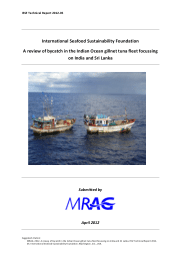Document: ISSF 2012-05: Bycatch in the Indian Ocean Gillnet Tuna Fleet. A review
The tuna fisheries of the Indian Ocean differ to those in other parts of the world in that artisanal and semi-industrial fisheries are responsible for over 54% of all catches , with gillnets responsible for 40% of all catch. The characteristics of the gillnet fisheries of Indian Ocean coastal States are largely unknown, as are levels of bycatch. Bycatch from gillnets is an issue of increasing global concern.
This report provides results of an initial study commissioned by ISSF in order to enable a snapshot characterisation of the bycatch rates of non-target species in key gillnet fisheries for tuna and tuna like species. It provides a brief description of Indian Ocean gillnet fleets and associated bycatch based on data available from the Indian Ocean Tuna Commission (IOTC) nominal catch database. It also collates and assesses available information on bycatch from India and Sri Lanka including compilation of local language grey literature and, where possible, interviews with local fishers. These two countries were highlighted due to relative ease of access to available information whilst noting that there are other major gillnet fisheries in the Indian Ocean. Levels of bycatch in gillnet fleets and areas that may warrant further study are highlighted.
Downloads: 472 | Views: 0
